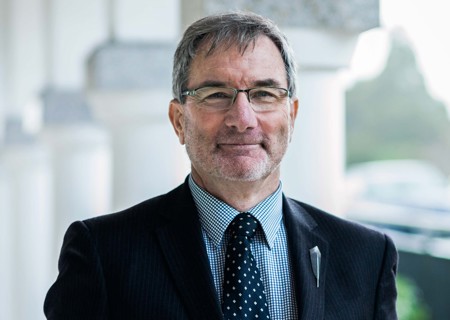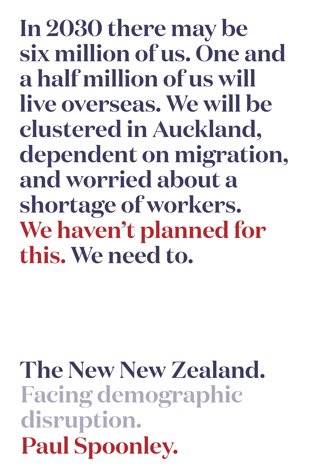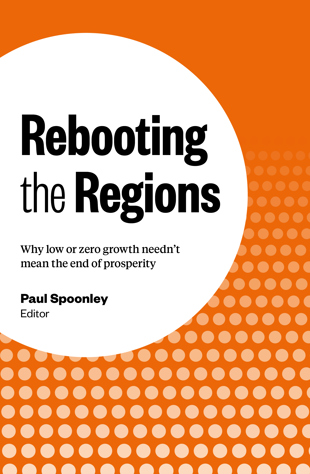Q1: You’ve written many books and are well acquainted with the highs and lows of the authorial life. But was this one just a bit different?
It is different — for two reasons. One is that I had been talking about demographic issues for several years on the Nine to Noon show with Kathryn Ryan, and I was bemused at some of the responses. Demography affects all of us in intimate and personal ways but many of us tend not to realise that these personal experiences reflect broad societal shifts. Some of the responses from listeners were hilarious and troubling in equal measure. This book seeks to make the connection between the personal and the societal. The other is that even though this is book number 28, I have never done anything like this before. I really enjoyed it, which is not something I can say about everything I write.
Q2: When and why did you decide that you just had to write it?
A few years ago, Massey University organised a roadshow and I contributed several presentations, in Taranaki, Hawkes Bay and Auckland. My bit concerned the idea of demographic change and disruption. I had my notes from the Nine to Noon shows and I was pleasantly surprised by the public interest at these presentations. Why not do a more extensive and accessible book? Enter Massey University Press.
Q3: It’s a wake-up call, right?
Absolutely. We talk about the significance of climate change or the fourth industrial revolution. Can we please talk about the huge demographic changes which are occurring, both locally and globally?
Q4: Because we have been passive, letting population change just ‘happen to us’?
I have a couple of frustrations. One is that we know what is coming in terms of demographic change but as a society, we seem reluctant to adjust how we think and act about some of the challenges that this change means for New Zealand. A “for instance” would be superannuation. We must talk about the age of superannuation eligibility or who gets superannuation. The ageing of New Zealand and what it means should not be a surprise to anyone. The other is that the nature of demographic change means that we really must develop new policies — where is this policy innovation going to come from? Who is going to lead this innovation? Or are we going to end up looking like Japan and Germany with all of the challenges they now face?
Q5: What were the particular challenges of writing this book?
Trying to write something that is engaging and interesting while talking about population statistics. Eyes glaze over and readers go to sleep when statistics are involved.
Q6: What did you relish?
Pulling together some of the more interesting perspectives on demographic change and applying them to New Zealand. I learnt a lot both about my own country and the literature and research available on demography. The preparation and writing was fascinating — and I hope that readers get a sense of this when they read the book.
Q7: The book is very collegial in that you pay tribute at many points to other demographers and social scientists. Why was it important to do that?
I first studied population geography under Brian Heenan in the 1970s — and I loved it then and still do. Brian died earlier in 2020, and Richard Bedford (who wrote Brian’s obituary) and I talked about his influence and what has happened since. New Zealand has some very talented demographers and population specialists — not many of them but they are excellent. And we need more demography if we are to understand the options facing us, and I wanted to pay tribute to these colleagues.
Q8: Just as the book reached its final stages we were hit by Covid19 and the lockdown. What did you then have to rethink?
It is one of those moments that challenges how we think about what is happening to our world. If ageing, declining fertility and the growing concentration of our population in a few centres, and specifically Auckland, are the grand themes of New Zealand’s current demography, then immigration has been equally — and in some regards, more — significant. Global mobility has come to a grinding halt and is unlikely to resume anytime soon, or certainly not to the same levels. What will that mean for New Zealand?
Q9: Our closed borders mean that some of the disruptions you analyse, and that were in train or well bedded in, will now be halted. But they will return and will still need to be addressed, won’t they?
I think that the halt to cross-border movements, whether in terms of short term visits (tourism, temporary work and study travel) or permanent migration, is something that is — and will be — hugely disruptive. But we have come to rely on this mobility for income and skills. Big chunks of contemporary economy rely on mobility and migration. Even if there are changes to the nature of this mobility, it will return and remain an important factor in our economy, our population growth and our talent recruitment. And New Zealand has generally “done” immigration well — good systems for recruitment and approval, social cohesion — even if the rates have been very high in the 2013 to 2019 period.
Q10: What do you hope that general readers take away from this book?
That we need to factor in demographic change into our policy and political discussions — and we need new policies to cater for the circumstances we face in the 21st century. Readers do not need to agree with my analysis, but they do need to understand the importance of demography in terms of who we are and what we should be doing.
Bonus question: And what do you hope that politicians and policy makers take away from it?
If there is a risk, and something that continues to trouble me, it is that politicians and policy makers are reluctant to consider very different policy options. But they need to! A few years ago, after an earlier book, Rebooting the Regions, I spent some time talking to local authorities and economic development agencies around New Zealand. It struck me how committed many were to a New Zealand that is disappearing (or has disappeared) rather than confronting the often challenging aspects of their community structure and population. There are some exceptions — good on them — but many are backward looking. They were more keen to talk about how dysfunctional Auckland had become and how they were seeing Aucklanders flock to their area, rather than the fact that they were facing population stagnation or decline, how they were seeing declining fertility and young adult outmigration, and migrants did not stay. We need some demographic realism and policy innovation.



